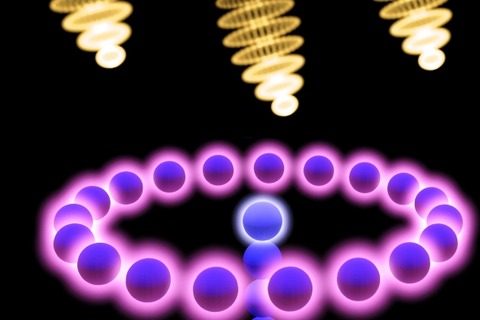Theorists create 'ultimate camera pixel'
22 Aug 2014

The effect of superradiance could be reversed to create a device capable of drawing-in light ultra-efficiently.
A team of theorists from Oxford University (OU) has adapted a quantum effect in which excited atoms team up to emit an enhanced pulse of light and turned on its head to create ’superabsorbing’ systems for making the ’ultimate camera pixel’.
Unfortunately, the advantage of this quantum effect is strongest when the atoms are already 50% charged. Thereafter, the system would rather release its energy back as light than absorb more, an OU statement said.
“A camera sensor harnessing the power of our superbsorbing rings would have very high time and spatial resolution
Study co-author Simon Benjamin
Now, however, the OU theorists claim to have found a solution to this problem.
A full account of the study has been published in the journal Nature Communications.
According to the research team, part of the answer came from biology.
“I was inspired to study ring molecules, because they are what plants use in photosynthesis to extract energy from the Sun,” said Kieran Higgins of OU’s Department of Materials, who led the work.
“What we then discovered is that we should be able to go beyond nature’s achievement and create a ’quantum superabsorber’,” he said.
Fundamental to the superabsorber’s design is a molecular ring at its core - which is charged to 50% by a laser pulse in order to reach the ideal superabsorbing state.
To maintain its condition, the team proposed exploiting a key property of the ring structure: each time it absorbs a photon, it becomes receptive to photons of a slightly higher energy.
Charging the device is like climbing a ladder whose rungs are increasingly widely spaced, the researchers said.
“Let’s say it starts by absorbing red light from the laser, once it is charged to 50% it now has an appetite for yellow photons, which are higher energy. And we’d like it to absorb new yellow photons, but not to emit the stored red photons,” Higgins said.
The theorists said this is achieved by embedding the device into a special crystal that suppresses red light - effectively making it harder for the ring to release its existing energy, so trapping it in the 50% charged state.
Vital to the superabsorbing ring’s design is a molecular ’wire’ that draws off the energy of newly absorbed photons.
“If you built a system with a capacity of 100 energy units the idea would be to ’half-charge’ it to 50 units, and the wire would then ’harvest’ every unit over 50,” said Kieran.
“It’s like an overflow pipe in plumbing - it is engineered to take the energy level down to 50, but no lower.”
Study co-author Simon Benjamin said that eventually, harvesting sunlight in highly-efficient way using superabsorbing systems might be possible.
“A more immediate application would be building an extremely sensitive light sensor that could form the basis of new camera technology,” Benjamin said.
“A camera sensor harnessing the power of our superbsorbing rings would have very high time and spatial resolution. And it could pave the way for camera technology that would exceed the human eye’s ability to see clearly both in dark conditions and in bright sunlight,” he added.

